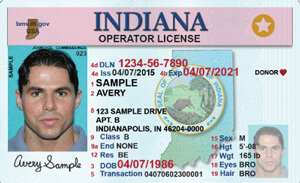- Updated for March 2025
- Based on 2025 IN commercial driver's license manual
Free Indiana CDL Permit Practice Test: General Knowledge 2025
For trucks and buses, Indiana provides important connections between the Midwest and other parts of the country. In particular, Interstate 65 passes through Indiana, connecting the Great Lakes to the Gulf of Mexico. Interstate 69 runs from Evansville, Indiana to Port Huron, Michigan. Interstate 70 and Interstate 74 connect Indianapolis to Ohio and Illinois. To drive commercial vehicles on any of these routes, you’ll need a Commercial Driver’s License (CDL).
There are three classes of CDLs. A Class A CDL allows you to operate combination vehicles with a Gross Combination Weight Rating (GCWR) of 26,001 pounds or more in which the towed vehicle weighs more than 10,000 pounds. To drive semi-trucks or tractor-trailers, this is the class of CDL you want. A Class B CDL allows you to operate a single vehicle with a Gross Vehicle Weight Rating (GVWR) of 26,001 pounds or more, or to tow a vehicle that does not exceed 10,000 pounds. This license is suitable for buses and straight trucks, including box trucks and most dump trucks. A Class C CDL allows you to operate relatively smaller vehicles designed to transport hazardous materials or 16 or more occupants (including the driver). Decide which class of CDL you want to apply for, based on the types of vehicles you expect to be driving in your career.
To obtain a CDL, there are a bunch of requirements you must meet. One of the most important is to pass a skills test, showing that you have mastered the skills of commercial driving. Mastering those skills will take a lot of practice. To practice commercial driving under supervision, you need a Commercial Learner’s Permit (CLP). To obtain a CLP, you must pass a written General Knowledge test and meet some other requirements, including passing a medical examination.
The General Knowledge test will assess your understanding of commercial driving theory, based on the official Indiana Commercial Driver’s License Manual. But it’s not easy to pass this test just by reading the manual, no matter how many times you read it. There are better study tools. This free Indiana CDL permit practice test is also based on the official manual, and it’s up to date as of March, 2025. Practicing with it will enable you to think about what you read in the manual, reinforcing it in your mind. To make your study easier, each of the 50 questions comes with a helpful hint and an explanation of the correct answer. The practice questions contained in this test will assess your knowledge of such topics as distracted driving, cargo management, driving emergencies, and stopping distance.
- Perfect for first-time and renewal CDL/CLP applicants, and those adding endorsements
- Triple-checked for accuracy
What you need to know

What to expect on the actual IN BMV exam
questions
correct answers to pass
passing score
List of questions (classic view)
- While driving at night, which lights should you use as often as you can?
- What is the penalty for your first conviction for driving under the influence (DUI)?
- When backing, it is important to use a helper
- "Operation Lifesaver" recommends that
- What is a common cause of tire fires?
- Which is NOT one of the four skill areas that operating a commercial vehicle requires?
- In which of the following two situations should you downshift?
- What is the definition of a hazard?
- Which of these is NOT part of the basic method for shifting up?
- If you double your speed, how much distance will it take to stop?
- Before transporting a sealed load, you must check
- Which of the following can cause a vehicle fire?
- Always try to back toward the driver's side because
- The most important hand signal you should agree on with a helper is
- It has just reached freezing. Which of the following areas may be slippery?
- How often must you stop to check your cargo while on the road?
- On which of the following types of fires should you NOT use a B:C fire extinguisher?
- Which of the following are likely to get stuck at a raised railroad crossing?
- Letting the air out of hot tires
- Signs of distracted drivers include
- An anti-lock braking system (ABS) will
- When beginning a long downgrade, which of the following should influence your choice of speed?
- Hazardous materials placards are
- Do empty trucks have the best braking?
- You should inspect wheel bearing seals for
- You should put the starter switch key into your pocket while you are performing the pre-trip inspection because
- Which of the following is a key steering component?
- How long does it take a typical tractor-trailer to clear a double railroad track?
- When you inspect the front of your vehicle as part of the walkaround inspection, which of the following do you NOT check?
- The minimum tread depth for front tires is
- What will help a drunk sober up?
- Total stopping distance is a combination of
- How many tiedowns are required for a 20-foot load?
- What can you do at an accident scene to help avoid another accident?
- Why should you cover your cargo?
- Before a trip, to prevent drowsiness, you should
- If you are confronted by an aggressive driver, you should
- You don't want to be a distracted driver, so you
- What is the best way to figure out how many seconds of following distance you have?
- What might happen if you swing wide to the left before you turn right?
- If the engine is not overheated, is it completely safe to remove the radiator cap?
- Which of the following is NOT true about an escape ramp?
- If you are traveling at 55 mph in a 30-foot vehicle, you should leave how many seconds of following distance?
- To transport cargo safely, which of the following are you NOT responsible for?
- How can you determine if your vehicle is equipped with an anti-lock braking system (ABS)?
- Which of the following should you NOT do if you experience a tire failure?
- Where should you place your warning devices if you must stop on a one-way road or divided highway?
- How can you start moving without rolling backward?
- If you feel drowsy while driving, what should you do?
- Common medications for colds
FAQs
How much does a CDL cost in Indiana?
The cost for a CDL in Indiana includes a $35 fee for the CDL itself and a $16 knowledge test fee. Additional fees may apply for skills testing and endorsements.
What disqualifies you from getting a CDL?
In Indiana, disqualifications from obtaining a CDL include major traffic violations, such as DUIs or reckless driving, certain criminal convictions, and medical conditions that impair safe driving abilities.
How do you obtain a CDL in Indiana?
To get a CDL in Indiana, first obtain a commercial learner's permit (CLP) by passing the required knowledge tests. Hold the CLP for at least 14 days, then complete CDL training (optional but recommended) and pass the skills test. Ensure you meet all medical and legal requirements.
Is CDL school mandatory?
CDL school is not mandatory in Indiana, but it's highly recommended for proper training and increased likelihood of passing the skills test. Some employers may require CDL training program completion.
What does the general knowledge test include?
The general knowledge test for a CDL in Indiana covers various topics such as basic vehicle operation, safe driving practices, reading road signs, and specific rules for commercial vehicles. It assesses the basic knowledge required for safely operating a commercial vehicle.
- Alabama: Test 1 / Test 2
- Alaska: Test 1 / Test 2
- Arizona: Test 1 / Test 2
- Arkansas: Test 1 / Test 2
- California: Test 1 / Test 2
- Colorado: Test 1 / Test 2
- Connecticut: Test 1 / Test 2
- Delaware: Test 1 / Test 2
- District of Columbia: Test 1 / Test 2
- Florida: Test 1 / Test 2
- Georgia: Test 1 / Test 2
- Hawaii: Test 1 / Test 2
- Idaho: Test 1 / Test 2
- Illinois: Test 1 / Test 2
- Indiana: Test 1 / Test 2
- Iowa: Test 1 / Test 2
- Kansas: Test 1 / Test 2
- Kentucky: Test 1 / Test 2
- Louisiana: Test 1 / Test 2
- Maine: Test 1 / Test 2
- Maryland: Test 1 / Test 2
- Massachusetts: Test 1 / Test 2
- Michigan: Test 1 / Test 2
- Minnesota: Test 1 / Test 2
- Mississippi: Test 1 / Test 2
- Missouri: Test 1 / Test 2
- Montana: Test 1 / Test 2
- Nebraska: Test 1 / Test 2
- Nevada: Test 1 / Test 2
- New Hampshire: Test 1 / Test 2
- New Jersey: Test 1 / Test 2
- New Mexico: Test 1 / Test 2
- New York: Test 1 / Test 2
- North Carolina: Test 1 / Test 2
- North Dakota: Test 1 / Test 2
- Ohio: Test 1 / Test 2
- Oklahoma: Test 1 / Test 2
- Oregon: Test 1 / Test 2
- Pennsylvania: Test 1 / Test 2
- Rhode Island: Test 1 / Test 2
- South Carolina: Test 1 / Test 2
- South Dakota: Test 1 / Test 2
- Tennessee: Test 1 / Test 2
- Texas: Test 1 / Test 2
- Utah: Test 1 / Test 2
- Vermont: Test 1 / Test 2
- Virginia: Test 1 / Test 2
- Washington: Test 1 / Test 2
- West Virginia: Test 1 / Test 2
- Wisconsin: Test 1 / Test 2
- Wyoming: Test 1 / Test 2
Your go-to, trusted source
Experience the Driving-Tests differenceOur commitment to accuracy and quality in our practice tests
Explore our rigorous, multi-tiered verification process that ensures each question mirrors the official manual for unparalleled accuracy.

At Driving-Tests.org, we understand the importance of reliable and accurate practice tests to help you prepare for your DMV exam. That's why we've developed a meticulous process to create and continually update our practice questions, ensuring they reflect the most current driving laws and regulations.
Here's an inside look at how we maintain the highest quality in our practice tests.
Content Creation and Verification Process
- Alignment with Official Manuals:
Every question we develop is based on the most recent version of each state's official driving manual. Our team regularly monitors each state DMV's website for the latest updates to ensure our practice tests are always aligned with the most current information. - Community Feedback Integration:
We leverage feedback from our vast community of users to understand which topics are most frequently tested. This helps us focus on the areas that are most relevant and beneficial for your preparation. - Expert Content Creation:
Our in-house editor, Steven, who has extensive experience in driver education, crafts each question with precision. He conducts a thorough review of each question against the official manuals to ensure accuracy. - Rigorous Review Process:
Once Steven has finalized a set of questions, our team conducts a joint review session. This second level of scrutiny involves content accuracy, proofreading, and fact-checking to eliminate any errors. - User Feedback Mechanism:
After a question goes live on our site, we keep the lines of communication open. Each question features a feedback button, inviting users to report any issues or errors. This continuous feedback loop allows us to address and rectify any concerns promptly. - Responsive Updates:
In line with our commitment to accuracy, we quickly update our practice questions to reflect any changes in the DMV manuals. Additionally, we update the free electronic copy of the state's driver's license manuals on our site, typically within a few days after the DMV publishes them.
Our thorough quality control process ensures that you have access to practice tests that are as accurate and up-to-date as possible. We believe in the power of well-prepared drivers and are dedicated to providing you with the best study tools to help you succeed on your DMV exam.
Pass the First Time – Guaranteed
You’re moments away from your results.
Before you view them, see how 1.15 million drivers used Premium to pass faster.
Real Exam-Like Indiana Questions
Get all exam-like questions seen on the real test.
99.06% Pass Rate vs. 49% Average
Most Premium users pass on their first try.
Money-Back Guarantee
We stand behind you until you pass.




